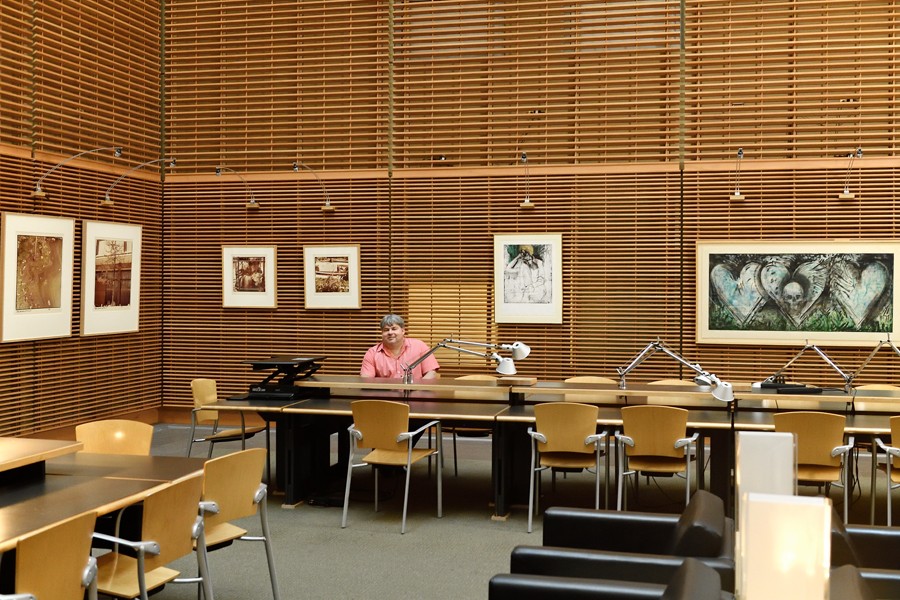There are no signs at the entrance, no docents roaming around the exhibition areas, not even any labels to say who created the works of art on display. But for almost 20 years, a first-rate collection of contemporary art has been hanging in an unexpected location, the Johns Hopkins Bloomberg School of Public Health.
The collection consists of 75 works by Robert Rauschenberg, Jim Dine, Robert Mapplethorpe, and other 20th-century American artists.
There are paintings, photographs, lithographs, etchings, woodcuts, and collages. Some of the larger works can be found in a first-level gallery, just inside the school's Monument Street entrance. More than three dozen of the pieces are by Rauschenberg—five are on the second floor; the rest line the walls of two fourth-level reading rooms, where students congregate at all hours.
All the pieces were donated to Johns Hopkins by Donald and Ruth Saff from their private collection. Donald Saff is a Brooklyn-born printmaker, art historian, and educator who specializes in contemporary art and collaborated with many of the artists whose works he collected, including Dine and Rauschenberg. He also has been a patient of Lawrence Cheskin, a physician and professor in the school's Center for Human Nutrition, and he and his wife gave the works because of that relationship.
"I wanted to celebrate Dr. Cheskin's work. And since his work relates to global issues, it seemed like the international language of art was the most appropriate gift," Saff says.
In an interview with The Baltimore Sun in 2004, when the donation was announced, Saff said that he was encouraged to donate art to Hopkins after learning how many significant artists already were represented in its collection, including works on the East Baltimore campus.
"I thought it was so unusual that when you went there you weren't looking at [Thomas] Kinkade's pastel landscapes or fake 19th-century impressionist paintings," he was quoted as saying. "It's the real deal of contemporary art, which sometimes isn't just pleasant background—it can be dissonant, and that's useful, too. It's much better than just being mesmerized by elevator music."
Cheskin says he was honored by the donation. "I was amazed and delighted that the Saffs thought enough of my work to want to support it in this way," he says.
The collection, he adds, sends a message to Hopkins students and staff "that they are in a very special place, one that places a value on art and its conducive effect on both learning itself and on working in a place of learning." The pieces, he says, "are timeless."
Saff, who turns 80 on Dec. 12, says the artists in the collection are among the "giants of the 20th century." He says he particularly likes the way the works are displayed in the reading rooms because people can see art on every wall and they can study the pieces over time, with repeated viewings. He says he wanted to provide an environment that's filled with art as high in quality as the education students receive at Hopkins.
"[The art] enters your eyes but also your heart because you're surrounded by it," he says of the collection. "It celebrates life. What better place for it than a school of public health?"
The works are primarily abstract images, created during the 1970s and 1980s and reflecting the artists' explorations of color, form, and space. One series consists of photographs of urban scenes that Rauschenberg made during a trip to China.
The variety of works is captured by some of the titles the artists gave them. There are the 1974 Airport Suite series by Rauschenberg, consisting of color relief and intaglio on fabric (and so-named because Rauschenberg signed the works in an airport waiting room); Tampa Orchid by Mapplethorpe, a color photogravure and screen print from the 1980s; and Eight Sheets From an Undefined Novel, a series of etchings that Dine made in the 1970s, including My Nights in Santa Monica and The Heart and the Wall. Eight Sheets was significant in Dine's evolution because it was the first series in which he made images of the human figure rather than of inanimate objects.
According to Andy Harrison, cultural properties archivist for the Alan Mason Chesney Medical Archives of the Johns Hopkins Medical Institutions, the Saff Collection originally was going to be displayed at Hopkins' Bayview campus, where Cheskin was based, but when Cheskin left Bayview to join the faculties of the schools of Public Health and Medicine, Saff asked that the gift be transferred to the School of Public Health, which completed a multiphase expansion between 1996 and 2004.
The collection was donated to Bayview in 2000 and transferred to Public Health in 2003. The pieces were displayed beginning in 2005.
Because the collection wasn't intended to be viewed in the same way it would be in a museum, the pieces aren't labeled as they typically would be in a museum, despite the caliber of the artists. You can, however, sometimes find their signatures as you encounter the pieces in their various locations.
Because of its home within the School of Public Health, the Saff Collection can't be seen by the general public without an appointment. But it can be viewed by anyone with a valid Johns Hopkins ID, whenever the building is open. That arrangement makes the Saff donation a hidden treasure in Hopkins' portfolio, with a limited number of viewers. But for those with an interest in late 20th-century art and artists—especially Rauschenberg and Dine—it's worth seeking out.
Posted in News+Info, Benefits+Perks
Tagged music + museums + more









